
The Solar-Terrestrial Centre of Excellence (STCE) is a collaborative network of the Belgian Institute for Space Aeronomy, the Royal Observatory of Belgium and the Royal Meteorological Institute of Belgium.
 |
Published by the STCE - this issue : 19 Mar 2015. The Solar-Terrestrial Centre of Excellence (STCE) is a collaborative network of the Belgian Institute for Space Aeronomy, the Royal Observatory of Belgium and the Royal Meteorological Institute of Belgium. |
| Archive of the newsletters | Subscribe to this newsletter by mail |
Friday 20 March, between 9:26BLT (8:26 UT) and 11:26 BLT (10:47 UT), a large, partial solar eclipse will be visible from Belgium.
Solar and radio telescopes in Uccle and Humain will closely monitor this spectacle. STCE scientists also collaborate with European scientists to observe the eclipse with one of the largest radio telescope networks in the world, called LOFAR. Satellites will also trace changes in the ionosphere, a layer of our Earth's atmosphere. Even in the event of bad weather and cloud cover, the decrease in light levels when the Moon is blocking most of the solar disk will be noticeable. The ionospheric and radio observations are not affected by cloud cover.
PROBA2, an ESA satellite built in Belgium and operated from the PROBA2 Science Centre in Uccle, will see the Sun in eclipse in the extreme ultraviolet from its orbit around the Earth. Far above the clouds, the satellite will witness two almost full solar eclipses. Part of the data and images from the first PROBA2 eclipse will be available late in the morning.
A solar eclipse is a once-in-a-lifetime experience. In the past, a total eclipse was the only way to observe the immediate environment around the Sun and to get an idea of the structure and composition of the solar atmosphere. It made scientists realize how complex and extended the solar atmosphere actually is. Nowadays, we have instruments that can create an artificial eclipse on a permanent base, but they suffer from technical limitations. Observing a solar eclipse in the normal way remains valuable for us scientists as it allows us to calibrate our solar instruments.
But above all, a solar eclipse offers us the opportunity to put our favorite study object in the picture and pass our enthusiasm. It's a science party for everyone!
All data and images of the observation campaign are brought together at http://sidc.be/eclipse2015/
This website also contains a brief explanation on the eclipse itself and how to observe it safely.
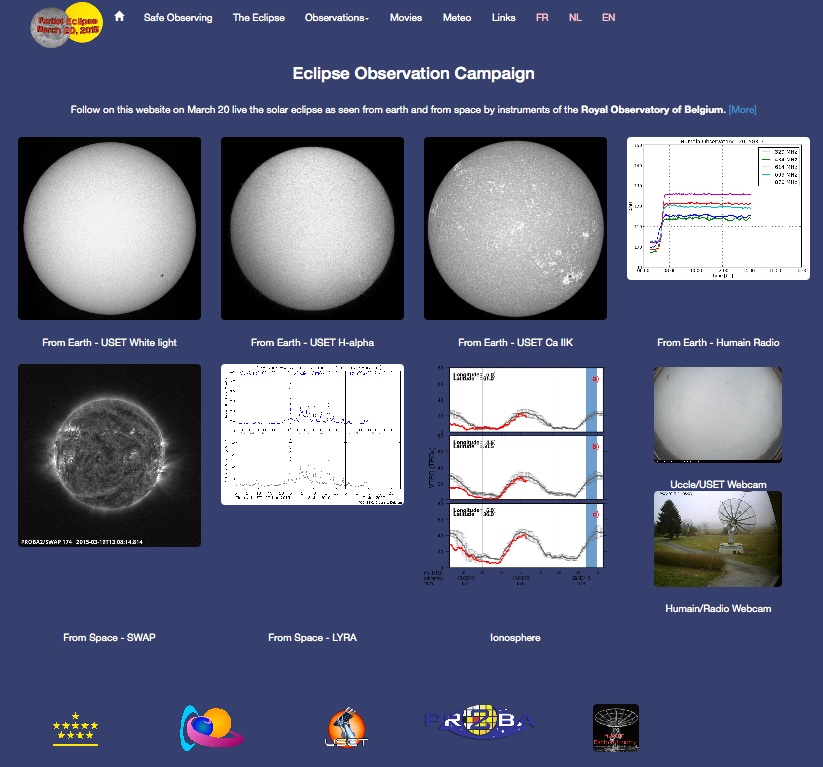
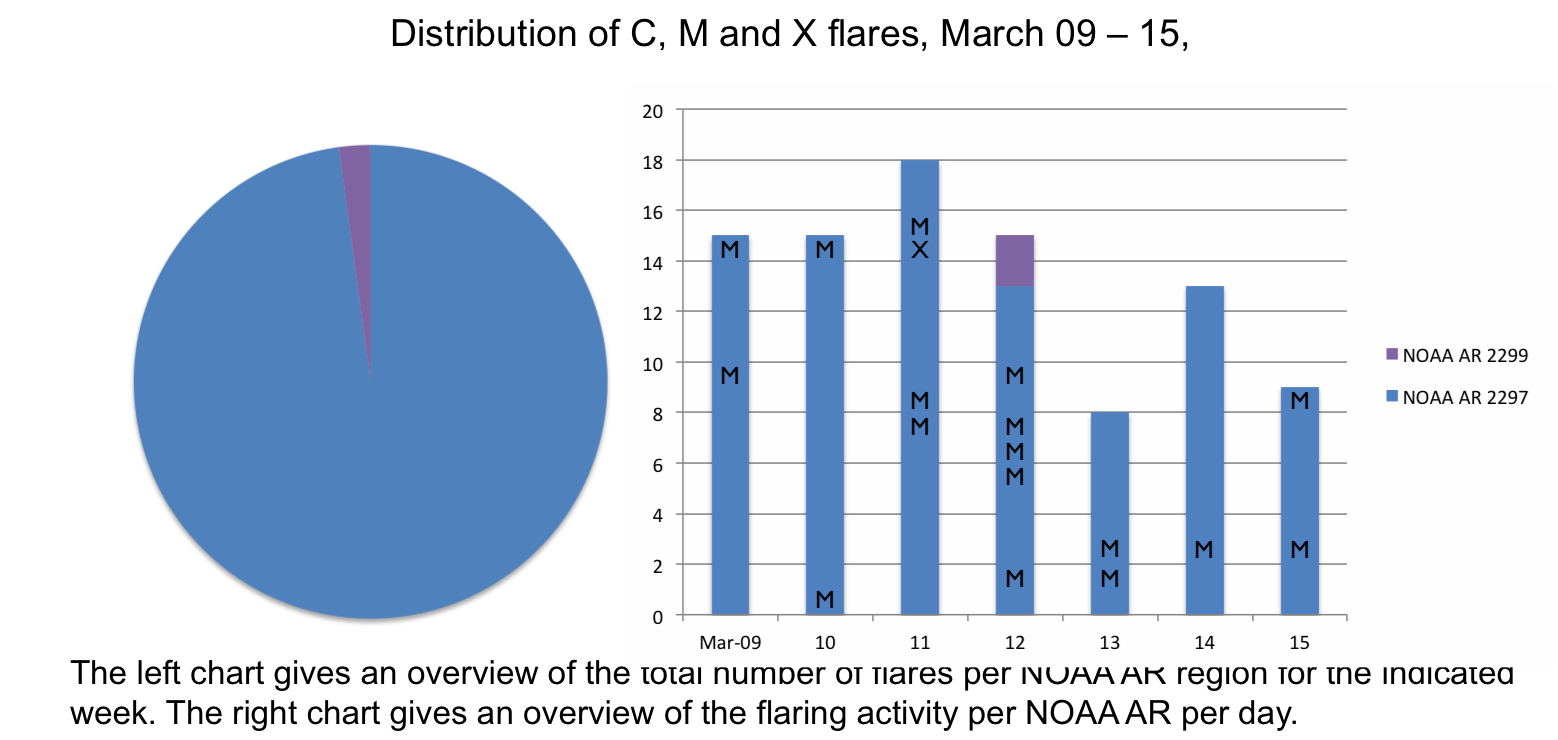
Over the past week NOAA AR (Active Region) 2297 was very active producing 17 M-class flares and 1 X-class flare.
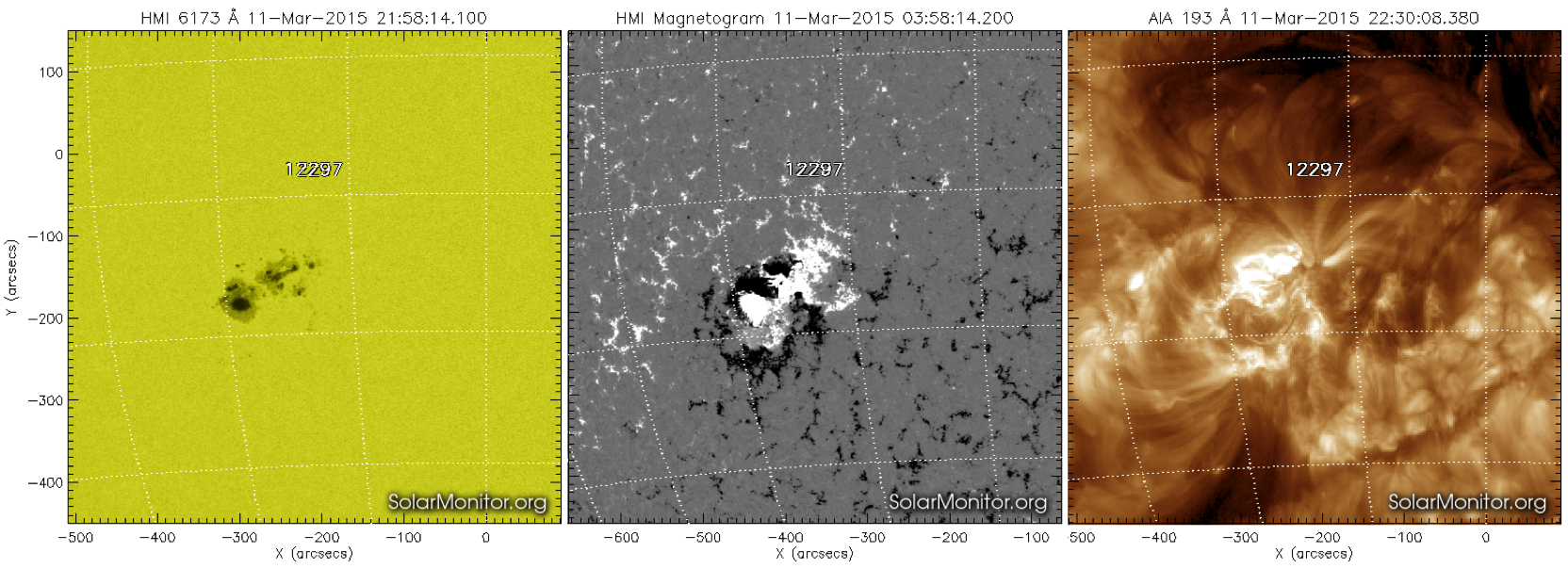
AR 2297 was located around central latitudes (S15), and rotated from the Eastern to the Western hemisphere. Throughout the week it grew in size and saw significant flux emergence. It was predominantly classified as a Beta-Gamma-Delta region under the Mount Wilson magnetic classification system. The largest flare, was an X2.1 flare, on Mar 11 peaking at 16:22UT. The left image and from SDO/HMI is AR 2297 in visible light, the middle magneto gram gives an idea of the strength of the photospheric magnetic field of the region, and right image show the active region in the corona.
AR 2298 has evolved into a Beta region, but showed little activity. AR 2299 rotated into view and exhibited a small amount of activity. AR 2301, which emerged near disk center on Mar 14, showed evidence of flux emergence, but has remained small.
There was a large filament located between S05W45 and S30E90 (on Mar 09), which remained stable for the whole week.
AR 2297 produced several CMEs (Coronal Mass Ejection) and continual flows throughout the week.
| DAY | BEGIN | MAX | END | LOC | XRAY | OP | 10CM | TYPE | Cat | NOAA |
| 09 | 1422 | 1433 | 1437 | S15E49 | M4.5 | 1N | III/2 | 2297 | ||
| 09 | 2329 | 2353 | 0012 | S18E45 | M5.8 | 2N | 170 | III/1IV/2 | 2297 | |
| 10 | 0319 | 0324 | 0328 | S15E40 | M5.1 | 2B | 130 | V/3III/3IV/1II/1 | 2297 | |
| 10 | 2346 | 0002 | 0006 | S16E28 | M2.9 | SF | 2297 | |||
| 11 | 0710 | 0718 | 0743 | S16E26 | M1.8 | 1B | 57 | 1 | 2297 | |
| 11 | 0751 | 0757 | 0803 | M2.6 | VI/2 | 1 | 2297 | |||
| 11 | 1611 | 1622 | 1629 | S17E21 | X2.1 | 2B | 160 | II/2 | 1 | 2297 |
| 11 | 1837 | 1851 | 1857 | S16E18 | M1.0 | 1N | 77 | V/2 | 1 | 2297 |
| 12 | 0441 | 0446 | 0450 | M3.2 | III/2 | 1 | 2297 | |||
| 12 | 1138 | 1150 | 1202 | M1.6 | 1 | 2297 | ||||
| 12 | 1209 | 1214 | 1218 | M1.4 | 220 | 1 | 2297 | |||
| 12 | 1350 | 1408 | 1413 | S15E6 | M4.2 | 2B | 53 | VI/1III/2V/2IV/1 | 1 | 2297 |
| 12 | 2144 | 2151 | 2156 | M2.7 | 230 | III/3V/3II/1 | 1 | 2297 | ||
| 13 | 0347 | 0401 | 0416 | M1.2 | 1 | 2297 | ||||
| 13 | 0549 | 0607 | 0612 | M1.8 | III/2 | 1 | 2297 | |||
| 14 | 0423 | 0440 | 0454 | S14W12 | M1.3 | 2N | 1 | 2297 | ||
| 15 | 0936 | 0940 | 0946 | S20W24 | M1.0 | SN | 1 | 2297 | ||
| 15 | 2242 | 2322 | 2338 | M1.2 | III/1 | 1 | 2297 |
| LOC: approximate heliographic location | TYPE: radio burst type |
| XRAY: X-ray flare class | Cat: Catania sunspot group number |
| OP: optical flare class | NOAA: NOAA active region number |
| 10CM: peak 10 cm radio flux |
There were 5 significant partial halo CMEs produced by AR 2297; at 22:24UT on 07 Mar, 00:00UT on 10 Mar, 03:36UT on 10 Mar, 08:24UT on 11 Mar and 02:00UT on 15 Mar. None of these appeared geoeffective.
However, proton numbers remained low throughout the week but began ramping up on 15 Mar which may have been produced by the CME produced on 10 Mar at 00:00UT.
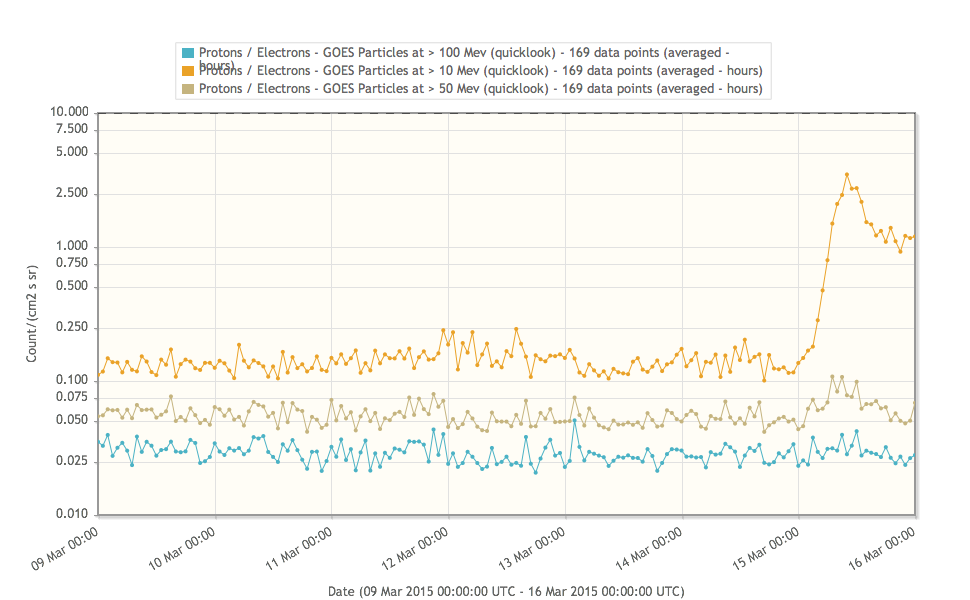
The solar wind speed has remained relatively constant over the past week, ranging from 300 km/s to 460 km/s - the yellow curve in the fourth pannel in the graph below. The total magnetic field has been stable around 5 nT, but has seen some growth over the past 24 hours. The Bz component has fluctuated from positive to negative, ranging between +5 and -5 nT, but this has increased to +10nT to -10nT late 15 Mar - the red curve in the top pannel.
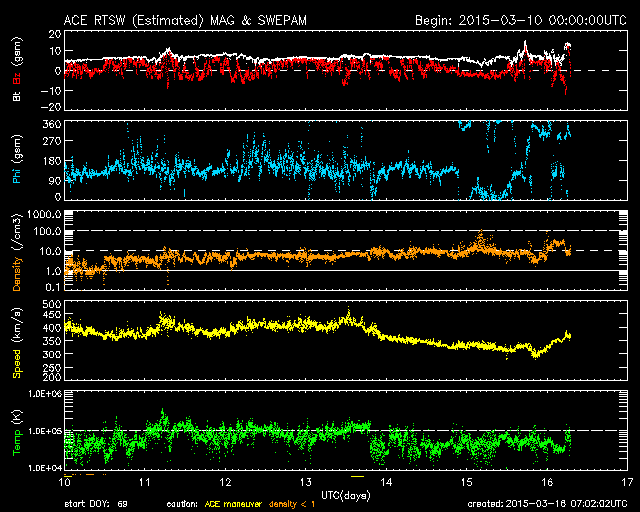
Geomagnetic conditions ranged between Kp index 0-4 (NOAA) and local K index 0-3 (Dourbes) over the past week. A small transient coronal hole located at central latitudes, rotated from S05W05 to S05W60 throughout the week, but showed little sign of enhancing solar wind conditions.

The figure shows the time evolution of the Vertical Total Electron Content (VTEC) (in red) during the last week at three locations:
a) in the northern part of Europe(N61°, 5°E)
b) above Brussels(N50.5°, 4.5°E)
c) in the southern part of Europe(N36°, 5°E)
This figure also shows (in grey) the normal ionospheric behaviour expected based on the median VTEC from the 15 previous days.
The VTEC is expressed in TECu (with TECu=10^16 electrons per square meter) and is directly related to the signal propagation delay due to the ionosphere (in figure: delay on GPS L1 frequency).
The Sun's radiation ionizes the Earth's upper atmosphere, the ionosphere, located from about 60km to 1000km above the Earth's surface.The ionization process in the ionosphere produces ions and free electrons. These electrons perturb the propagation of the GNSS (Global Navigation Satellite System) signals by inducing a so-called ionospheric delay.
See http://stce.be/newsletter/GNSS_final.pdf for some more explanations ; for detailed information, see http://gnss.be/ionosphere_tutorial.php
Start : 2015-04-28 - End : 2015-05-01
At present, solar researches and study of active late-type stars
achieve a significant advance thanks new observational facilities
and progress of the theory. The problems of an evolution of
activity at the billion year-time-scales start to be discussed.
Superflares were detected on stars younger than the Sun, and the
frequency of superflares occurrence was evaluated. The first
hypotheses were proposed for evaluation of flare activity level and
expected stellar wind fluxes at the epoch when the regular cycle on
the Sun was only established. Now it is a time to discuss further
directions of perspective investigations which are essential for
evaluation of space factor affecting on geo- and bio-sphere in
those epochs and space weather forecast.
Website:
http://www.tau.ac.il/institutes/advanced/cosmic/Conferences/2015-VarSITI_Superflares/VarSITI-2015_ISR.html
Start : 2015-05-02 - End : 2015-05-08
Start : 2015-05-18 - End : 2015-05-22
URSI AT-RASC 2015 will be the first edition of the newly
established triennial URSI Atlantic Radio Science Conference as one
of the URSI Flagship Conferences. AT-RASC 2015 will have an open
scientific program composed of submitted papers within the domains
covered by all ten Commissions of URSI.
Website: http://www.at-rasc.com/
Start : 2015-05-25 - End : 2015-05-29
25-27 May 2015: BUKS 2015 - MHD waves: Observational aspects
from ground to space - MHD waves: Theory - where are we? - MHD
instabilities
27-28 May 2015: Ruderman Honorary meeting - Theory of linear MHD
waves - MHD waves instabilities - Non-linear waves in plasmas
29 May 2015: Joint BUKS/Ruderman's conferences excursion -
Boat excursion to Szentendre, Visegrad and Esztergom
Website:
http://swat.group.shef.ac.uk/Conferences/BUKS_2015/index.html
Start : 2015-06-01 - End : 2015-07-24
The Space Weather Summer School at Los Alamos National
Laboratory, established in 2011 under the founding Director Josef
Koller, is dedicated to space weather, space science and
applications. Every year we solicit applications for the Los Alamos
Space Weather Summer School. This summer school is sponsored and
supported by a number or organizations at LANL. This year our top
sponsors include the Los Alamos Institute of Geophysics, Planetary
Physics and Signatures (IGPPS) and the Laboratory Directed Research
and Development Office (LDRD). The summer school brings together
top space science students with internationally recognized
researchers at LANL in an educational and collaborative
atmosphere.
Website:
http://www.swx-school.lanl.gov/
Start : 2015-06-08 - End : 2015-06-12
The RadioSun Workshop and Summer School 2015 is the fourth
international academic seminar supported by the International
Research Staff Exchange Scheme of the Seventh Fromework Programme
of the European Union (FP7-IRSES-295272-RADIOSUN). The aims of this
project are to establish close research interaction and
collaboration between the key EU and non-EU research groups
involved in the research of the Sun in the radio band;
qualitatively advance our knowledge of the physical processes
operating in the solar atmosphere, the basic mechanisms responsible
for its evolution and dynamics and its effect on the Earth; and
provide younger researchers with extensive training in relevant
research techniques and with universal transfer.
Website:
http://www2.warwick.ac.uk/fac/sci/physics/staff/research/davidpascoe/radiosun
Start : 2015-06-09 - End : 2015-06-12
The last five years have seen substantial progress in our
understanding of the solar dynamo, fueled by continuing advances in
observations and modeling. With the launch of NASA's Solar Dynamics
Observatory (SDO) in 2010 came an unprecedented window on the
evolving magnetic topology of the Sun, highlighting its intricate
3D structure and global connectivity. The Helioseismic Magnetic
Imager (HMI) instrument on SDO in particular has provided
potentially transformative yet enigmatic insights into the internal
dynamics of the solar convection zone that underlie the dynamo.
Attempts to detect subsurface convective motions from helioseismic
inversions have yielded only upper limits on the large-scale
convective amplitude, challenging our understanding of global solar
convection. Yet, potential signatures of giant cells have been
detected in photospheric Dopplergrams. Estimates of the meridional
flow from HMI and complementary instruments (SOHO/MDI and GONG)
have been equally tantalizing and enigmatic. Several disparate
techniques, including local and global helioseismic inversions and
correlation tracking of surface features, have yielded evidence of
a multi-cellular meridional flow but they differ on the detailed
flow structure and amplitude. This multi-cellular meridional flow
has potentially profound implications for flux-transport dynamo
models that previously assumed a very different structure with a
single circulation cell per hemisphere.
Website:
https://www2.hao.ucar.edu/Workshop/Solar-Dynamo-Frontiers
Start : 2015-07-13 - End : 2015-07-24
The CISM Summer School is intended to give students a
comprehensive immersion in the subject of space weather: what it
is, what it does, and what can be done about it. Space weather is
many things: beautiful when seen through the eyes of a sun-viewing
telescope, fascinating when studied for its alien worlds of
magnetic structures and phenomena, awesome when witnessed as a
solar eruption or auroral storm, and devastating to the users of
services it disrupts. Space weather links the Sun, the Earth, and
the space in between in a branching chain of consequences. Weather
systems on the Sun can spawn interplanetary storms of colossal size
and energy that envelop the whole planet in electrical hurricanes.
Such storms attack high-tech, complex, and expensive technological
systems that provide much of the infrastructure that allows modern
society to function.
Website:
https://www2.hao.ucar.edu/Events/2015-CISM-Summer-School
Start : 2015-07-21 - End : 2015-07-23
The conference will review past and recent achievements, as well
as future challenges in the field of solar coronal loop
physics.
Website:
http://www.damtp.cam.ac.uk/user/astro/cl7/index.html
Start : 2015-07-28 - End : 2015-08-04
Heliophysics is all of the science common to the field of the
Sun-Earth connections. This fast-developing field of research
covers many traditional sub-disciplines of space physics,
astrophysics, and climate studies. The NASA Living with a Star
program, with its focus on the basic science underlying all aspects
of space weather, acts as a catalyst to bring the many research
disciplines together to deepen our understanding of the system of
systems formed by the Sun-Earth connection.
Website:
http://www.heliophysics.ucar.edu/
Start : 2015-07-30 - End : 2015-08-06
The 34th International Cosmic Ray Conference (ICRC) will be held
from July 30 to August 6, 2015, in The Hague, The Netherlands. It
is an important and large conference in the field of Astroparticle
Physics. The ICRC covers: cosmic-ray physics, solar and
heliospheric physics, gamma-ray astronomy, neutrino astronomy, and
dark matter physics.
Website: http://icrc2015.nl
Start : 2015-08-31 - End : 2015-09-04
The purpose of this conference is to discuss the latest
questions and results in solar and stellar physics. Solar and
stellar seismology will be one particular focus but contributions
on all aspects of solar-stellar relations will be welcome. We aim
to establish links and synergies between the day- and night-time
fields of astrophysics.
Website:
http://www.iac.es/congreso/solarnet-3meeting/
Start : 2015-09-02 - End : 2015-09-04
The Workshop will address how the joint exploration of the
corona and inner heliosphere will lead to advances in our
understanding of coronal heating and solar wind acceleration, the
magnetic and plasma structure of the heliosphere, and the
acceleration of energetic particles at shocks and flares. The
workshop will inspire research that will make use of SO and SPP
observations within the context of the NASA Heliophysics
Observatory System and identify key areas for preparatory research.
Synergistic observations from other ground based and space based
assets will also be addressed.
Website:
http://www.solarprobeplus.org/2015/
Start : 2015-10-05 - End : 2015-10-09
This CSPM-2015 scientific meeting will cover various aspects of
solar dynamic and magnetic phenomena which are observed over the
entire electromagnetic spectrum: white-light, Hα, Ca II,
and radio from ground and in a variety of other wavelengths (white
light, UV and EUV, and X-rays) from space. Emphasis will also be
placed on instrumentation, observing techniques, and solar image
processing techniques, as well as theory and modelling through
detailed radiative transfer in increasingly realistic MHD models.
The long-term (cyclic) evolution of solar magnetism and its
consequence for the solar atmosphere, eruptive phenomena, solar
irradiation variations, and space weather, will be in focus. Here,
special attention will be devoted to the long-term observations
made in Coimbra and also to the results of the SPRING / SOLARNET
and SCOSTEP VarSITI studies. In particular, the weak solar activity
during the current solar maximum will be discussed. Finally, since
this meeting is organised around the 90th anniversary of performing
the first spectroheliographic observations in Coimbra, a session
will be specially dedicated to new solar instruments (both
ground-based and space-borne) that will give access to unexplored
solar atmospheric features and dynamic phenomena over the coming
years.
Website:
http://www.mat.uc.pt/~cspm2015/
Start : 2015-10-19 - End : 2015-10-23
The workshop aims to gather experts from the various fields of
remote sensing observations of the inner heliosphere,
including white light, EUV, and radio observation,
together with modellers in order to tackle key outstanding science
and space weather operational issues, establish closer
working relations, and devise the best ways to move the field
forward as a whole. In addition, the science learned from remote
Âsensing observations is critical to improving our
capabilities of space weather forecasting. The workshop
aims to look at ways in which we can more easily and efficiently
share and access the various types of data between individual
groups and subÂcommunities and to officially launch the
IPS Common Data Format v1.0 (IPSCDFv1.0) now in use. It also aims
to allow investigations into ways in which we model the inner
heliosphere looking at the advantages and disadvantages of the
available modelling, updates on present and future
remoteÂsensing capabilities, and investigating further
the ways in which these data sets all complement each other and are
necessary to gain knowledge and understanding of the fundamental
physical processes that occur within the inner heliosphere. These
are critical processes that are key to both Heliophysics science as
well as to spaceÂweather operations and forecasting.
Website:
http://www.sciesmex.unam.mx/workshop2015/
Start : 2015-11-10 - End : 2015-11-13
Observations of the Sun and Earth from space have revolutionized
our view and understanding about impacts of solar variability and
anthropogenic forcing on Earth climate. For more than three solar
cycles since 1978, the total and spectral solar irradiance (TSI and
SSI) and global terrestrial atmosphere/surface have been observed
continuously, enabling unprecedented quality data for Sun-climate
studies. The primary objective of this symposium is to convene
climate scientists, solar physicists, and experimentalists together
for a better understanding how Earth climate system changes and
responds to solar variability.
Website:
http://lasp.colorado.edu/home/sorce/news-events/meetings/2015-sun-climate-symposium/
Start : 2016-07-30 - End : 2016-08-07
The 41st COSPAR Scientific Assembly will be held in Istanbul,
Turkey from 30 July - 7 August 2016. This Assembly is open to all
bona fide scientists.
Website:
https://www.cospar-assembly.org/
Presentation given during a users' visit about the STCE operational space weather services and products.
http://www.spaceweather.eu/en/repository/show?id=558
Presentation given during a users' visit about the STCE operational space weather services and products.
http://www.spaceweather.eu/en/repository/show?id=559
Presentation given during a users' visit about the STCE operational space weather services and products.
http://www.spaceweather.eu/en/repository/show?id=560
Presentation given during a users' visit about the STCE operational space weather services and products.
http://www.spaceweather.eu/en/repository/show?id=561
Presentation given during a users' visit about the STCE operational space weather services and products.
http://www.spaceweather.eu/en/repository/show?id=562
Presentation given during a users' visit about the STCE operational space weather services and products.
http://www.spaceweather.eu/en/repository/show?id=563
Invited review submitted to the journal Revue E. This article is the first in a series of 3 articles.
De Zon, Helios, Sol, ... er bestaan vele namen voor die gele bol die dagelijks ons hemelgewelf doorkruist en onze warmte- en lichtbron bij uitstek is. Dankzij satellietwaarnemingen hebben we onze ster leren kennen als een dyna- misch en explosief hemelobject dat aan de basis ligt van het zogenaamde ruimteweer dat een belangrijke impact heeft op onze technologie.
http://www.spaceweather.eu/en/repository/show?id=564
On the occasion of the solar eclipse of March 20, 2015, we contributed to the March 2015 edition of the amateur astronomer journal 'Zenit'. We highlighted the outcome of LASCO onboard of SOHO and focussed on the role of the STCE on space missions like PROBA2, PROBA3 and Solar Orbiter.
The text is written in Dutch.
http://www.spaceweather.eu/en/repository/show?id=565